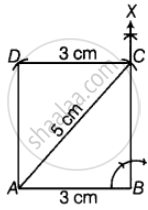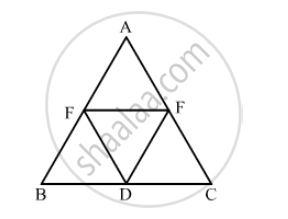Advertisements
Advertisements
प्रश्न
Construct a rectangle whose one side is 3 cm and a diagonal equal to 5 cm.
उत्तर
We know that, diagonals of a rectangle and opposite sides are equal.
All the angles of rectangle are right angle.
So, AC = 5 cm
AB = 3 cm
Steps of construction:
Step I: Draw AB = 3 cm.
Step II: Draw a ray BX such that ∠ABX = 90°.
Step III: Draw an arc such that AC = 5 cm.
Step IV: With B as centre, draw an arc of radius 5 cm. With C as centre, draw another arc of radius 3 cm which intersect first arc at a point, suppose D.
Step V: Join CD and AD.
Thus, ABCD is the required rectangle.
APPEARS IN
संबंधित प्रश्न
In a parallelogram ABCD, the diagonals bisect each other at O. If ∠ABC = 30°, ∠BDC = 10° and ∠CAB = 70°. Find:
∠DAB, ∠ADC, ∠BCD, ∠AOD, ∠DOC, ∠BOC, ∠AOB, ∠ACD, ∠CAB, ∠ADB, ∠ACB, ∠DBC and ∠DBA.
In the following figure, BDEF and DCEF are each a parallelogram. Is it true that BD = DC? Why or why not?

Which of the following statement is true for a rectangle?
Its diagonals are equal.
Which of the following statement is true for a rectangle?
Its diagonals are perpendicular.
Diagonals of a rectangle ABCD intersect at point O. If AC = 8 cm then find BO and if ∠CAD =35° then find ∠ACB.
State with Reason Whether the Following Statement is ‘True’ Or ‘False’.
Every rectangle is a parallelogram.
Draw a rectangle ABCD such that l(AB) = 6.0 cm and l (BC) = 4.5 cm.
Show that the bisectors of angles of a parallelogram form a rectangle
If the diagonals of a quadrilateral are equal and bisect each other, then the quadrilateral is a ______.
Every trapezium is a rectangle.
